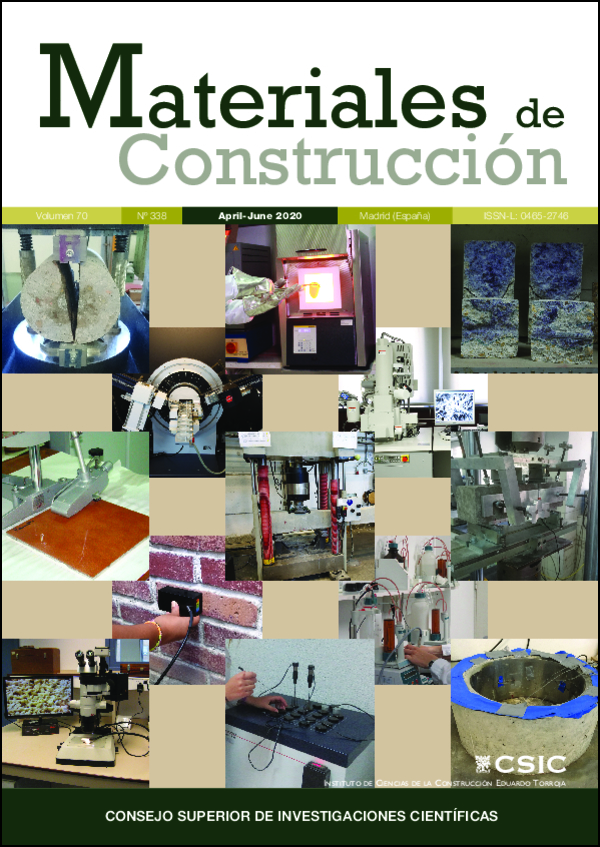Estimación de la resistencia a compresión simple del jabre estabilizado “in situ” con cemento como material en la formación de explanadas de carreteras
DOI:
https://doi.org/10.3989/mc.2020.09019Palabras clave:
Granito, Cemento con adiciones, Curado, Resistencia a la compresión, ModelizaciónResumen
La roca granítica presenta habitualmente un horizonte de alteración con varios metros de potencia. La arena arcillosa resultante como producto de alteración se denomina comúnmente jabre. Aunque la fórmula de trabajo de la estabilización de jabre con cemento se verifique correctamente en tramos de prueba, la estabilización “in situ” del jabre con cemento presenta habitualmente elevadas dispersiones. Entre los ensayos de laboratorio efectuados se encuentran los ensayos de análisis granulométrico, límites de Atterberg, resistencia a compresión simple (RCS), la densidad y humedad sobre probetas de suelo estabilizado, Proctor modificado, índice CBR (California Bearing Ratio) y el plazo de trabajabilidad de la mezcla con cemento. La curva de endurecimiento del suelo estabilizado fue ajustada mediante un modelo multilineal. Aunque tradicionalmente se especifique la RCS a 7 días, buscando definir un mejor comportamiento del material, los autores calcularon otros modelos de jabre estabilizado para roturas a 7, 14 y 28 días.
Descargas
Citas
Garcia-Talegon, J.; Iñigo, A.C.; Vicente-Tavera, S.; Molina-Ballesteros, E. (2016) Silicified Granites (Bleeding Stone and Ochre Granite) as Global Heritage Stones Resources from Avila (Central of Spain). Geosci. Canada. 43 [1], 53-62. https://doi.org/10.12789/geocanj.2016.43.087
Champiré, F.; Fabbri, A.; Morel, J.-C.; Wong, H.; McGregor, F. (2016) Impact of relative humidity on the mechanical behavior of compacted earth as a building material. Construc. Build. Mater. 110 [1], 70-78. https://doi.org/10.1016/j.conbuildmat.2016.01.027
UNE-EN 13286-51. (Una Norma Española - European Norm). (2006) Unbound and hydraulically bound mixtures - Part 51: Method for the manufacture of test specimens of hydraulically bound mixtures using vibrating hammer compaction.
Ministry of Public Works. (2014) General Specifications for Roads and Bridges Works (PG-3). 5th Part Pavements, 50-312.
UNE-EN 13286-41. (2003) Unbound and hydraulically bound mixtures - Part 41: Test method for the determination of the compressive strength of hydraulically bound mixtures.
UNE 103501. (1994) Geotechnics. Compaction test. Modified Proctor.
UNE 103900. (2013) In situ determination of density and moisture content of soil and granular materials by nuclear methods: low depths.
UNE-EN 933-2. (1996) Test for geometrical properties of aggregates. Part 2: determination of particle size distribution. Test sieves, nominal size of apertures.
UNE 103101. (1995) Particle size analysis of a soil by screening.
UNE 103103. (1994) Determination of the liquid limit of a soil by the Casagrande apparatus method.
UNE 103104. (1993) Test for plastic limit of a soil.
Anagnostopoulos, C.A. (2015) Strength properties of an epoxy resin and cement-stabilized silty clay soil. Appl. Clay Sci. 114, 517-529. https://doi.org/10.1016/j.clay.2015.07.007
Niu, X.; Xie, H.; Sun, Y.; Yao, Y. (2017) Basic Physical Properties and Mechanical Behavior of Compacted Weathered Granite Soils. Inter. J. Geomechan. 17 [10]. https://doi.org/10.1061/(ASCE)GM.1943-5622.0000983
Wu, Y.; Yamamoto, H.; Izumi, A. (2016) Experimental Investigation on Crushing of Granular Material in One- Dimensional Test. Period. Polytech. Civil Engineer. 60 [1], 27-36. https://doi.org/10.3311/PPci.8028
Kariyawasam, K.K.G.K.D.; Jayasinghe, C. (2016) Cement stabilized rammed earth as a sustainable construction material. Construc. Build. Mater. 105, 519-527. https://doi.org/10.1016/j.conbuildmat.2015.12.189
Kasama, K.; Zen, K.; Iwataki, K. (2007) High-strengthening of cement-treated clay by mechanical dehydration. Soils Found. 47 [2], 171-184. https://doi.org/10.3208/sandf.47.171
Liu, Z.B.; Xie, S.Y.; Shao, J.F.; Conil, N. (2015) Effects of deviatoric stress and structural anisotropy on compressive creep behavior of a clayey rock. Appl. Clay Sci. 114, 491-496. https://doi.org/10.1016/j.clay.2015.06.039
Saldanha, R.; Consoli, N.C. (2016) Accelerated Mix Design of Lime Stabilized Materials. J. Mater. Civil. Engin. 28 [3]. https://doi.org/10.1061/(ASCE)MT.1943-5533.0001437
Fernández-Ledesma, E.; Jiménez, J.R.; Ayuso, J.; Corinaldesi, V.; Iglesias-Godino, F.J. (2016) A proposal for the maximum use of recycled concrete sand in masonry mortar design. Mater. Construc. 66 [321], e075. https://doi.org/10.3989/mc.2016.08414
UNE 103808. (2006) Load test of plate soils.
Ministry of Public Works. Instruction for the reception of cements RC-16. (2016).
UNE-EN 13286-45. (2004) Unbound and hydraulically bound mixtures - Part 45: Test method for the determination of the workability period of hydraulically bound mixtures.
Yu, C.; Liao, R.; Zhu, C.; Cai, X.; Ma, J. (2018) Test on the stabilization of Oil-Contaminated Wenzhou Clay by Cement. Advanc. Civil Engineer. 2018, 9675479. https://doi.org/10.1155/2018/9675479
Amadi, A.A.; Osu, A.S. (2018) Effect of curing time on strength development in black cotton soil - Quarry fines composite stabilized with cement kiln dust (CKD). J. King Saud Univ. - Engineer. Sci. 30 [4], 305-312. https://doi.org/10.1016/j.jksues.2016.04.001
Li, Q.; Chen, J.; Shi, Q.; Zhao, S. (2014) Macroscopic and Microscopic Mechanisms of Cement-Stabilized Soft Clay Mixed with Seawater by Adding Ultrafine Silica Fume. Advanc. Mater. Sci. Engineer. 2014, 810652. https://doi.org/10.1155/2014/810652
Rahmi, A.; Taib, S.; Sahdi, F. (2018) Investigation of the Application of Various Water Additive Ratios on Unconfined Compressive Strength of Cement-Stabilized Amorphous Peat at Different Natural Moisture Contents. Advanc. Civil Engineer. 2018, 1945808. https://doi.org/10.1155/2018/1945808
Publicado
Cómo citar
Número
Sección
Licencia
Derechos de autor 2020 Consejo Superior de Investigaciones Científicas (CSIC)

Esta obra está bajo una licencia internacional Creative Commons Atribución 4.0.
© CSIC. Los originales publicados en las ediciones impresa y electrónica de esta Revista son propiedad del Consejo Superior de Investigaciones Científicas, siendo necesario citar la procedencia en cualquier reproducción parcial o total.
Salvo indicación contraria, todos los contenidos de la edición electrónica se distribuyen bajo una licencia de uso y distribución “Creative Commons Reconocimiento 4.0 Internacional ” (CC BY 4.0). Consulte la versión informativa y el texto legal de la licencia. Esta circunstancia ha de hacerse constar expresamente de esta forma cuando sea necesario.
No se autoriza el depósito en repositorios, páginas web personales o similares de cualquier otra versión distinta a la publicada por el editor.
















